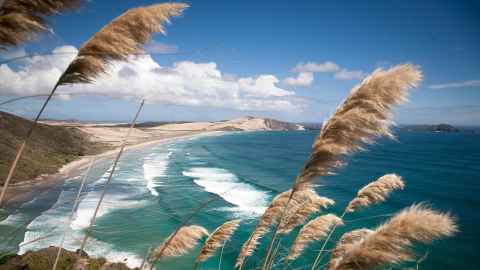How climate change may alter New Zealand's waves
04 November 2022
That summer wave you catch will be different under an altering climate.

Climate change may reduce the heights of New Zealand’s waves from today’s levels in autumn and summer and increase wave heights in spring and winter, according to modelling by University of Auckland scientist Dr João Albuquerque.
Overall, waves may reduce in height on the east coast and gain in height on the west coast.
These changes are likely to become more and more evident as the end of the century approaches.
“People might just expect waves to get bigger under climate change, but the picture is a lot more complicated,” says Dr Albuquerque.
The modelling also indicated shifts in wave direction, with implications for coastal erosion as waves hit the shore at altered angles.
The research was published today, coincidentally just ahead of the United Nations climate change conference called COP27, which starts in Egypt on Sunday.

Dr Albuquerque and colleagues including Professor Giovanni Coco, of the University’s School of Environment, drew on information from global climate models used by the International Panel for Climate Change to generate projections of the New Zealand wave climate.
The scientists made projections for 2026-45 and 2081-2100 under a high emissions global warming scenario (RCP8.5) and a moderate emissions scenario (RCP4.5).
Winds are the key driver of waves and changes in two atmospheric effects, the westerly jet stream and the subtropical ridge, will be key in altering winds around New Zealand and therefore waves, says Dr Albuquerque.
From 2026 to 2045, the main effect may be a small wave height increase (a maximum of five percent) along the South Island’s west coast.
Through the end of the century, wave heights may increase by five percent to 10 percent on the west coasts of both islands, with the effect stronger in the south than the north. Wave heights along the east of both islands may decrease by five percent to 20 percent. (The ranges account for both emissions scenarios.)
The study is the first to project how New Zealand’s waves will change
Dr Albuquerque modelled the oceans around New Zealand at a 10-kilometre resolution.
Overall, averaging out seasonal variations, surfers and swimmers at Ōhope and Mt Maunganui in the Bay of Plenty may encounter waves more than 10 percent smaller in height by the end of the century.
Waves could gain in height at Auckland’s Piha and Waikato’s Raglan. At Carters Beach at Westport the maximum projected increase is more than 6 percent. At Dunedin’s St Kilda, projections range from a 0.1 percent gain to a 13 percent decline.
The study was the first to project how New Zealand’s waves will change, also looking at factors including the frequency and intensity of storms.
“Researchers can use the database we’ve generated for free, and that’s already happening,” says Dr Albuquerque. “It’s a great, publicly available resource for studying the potential use of waves in renewable energy, and for risk assessment and mitigation of future coastal hazards like flooding and erosion.”

Dr Albuquerque’s work started in 2016 as part of a thesis for his PhD and culminated, more than 4200 supercomputer sessions later, in the publication of the results today in the New Zealand Journal of Marine and Freshwater Research.
The project was led by Professor Coco. Co-authors of the paper were Assistant Professor Jose A. A. Antolínez, of the Netherlands, and Associate Professor Fernando J. Méndez, of Spain. The research used supercomputers at New Zealand eScience Infrastructure (NeSI).
Dr Albuquerque is now working as a physical oceanography consultant at MetOcean Solutions. “I am still modelling waves, but now I tend to look at the effects of long waves inside harbours and ports,” he says. His work has also included modelling tropical cyclones.
Media contact
Paul Panckhurst | media adviser
M: 022 032 8475
E: paul.panckhurst@auckland.ac.nz